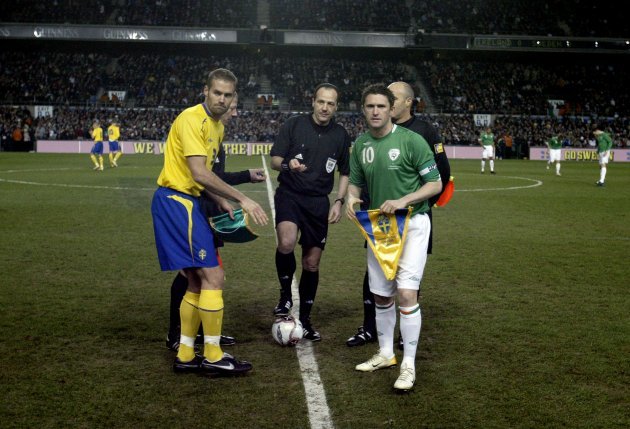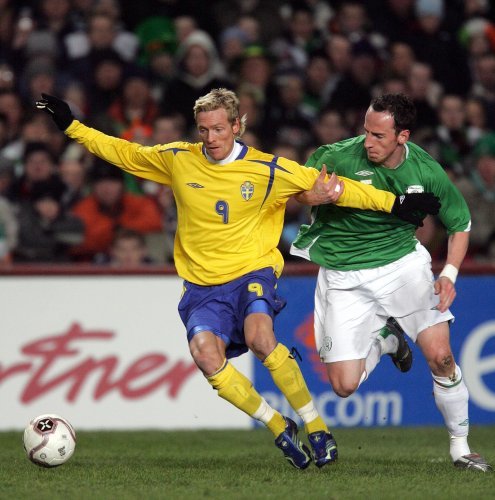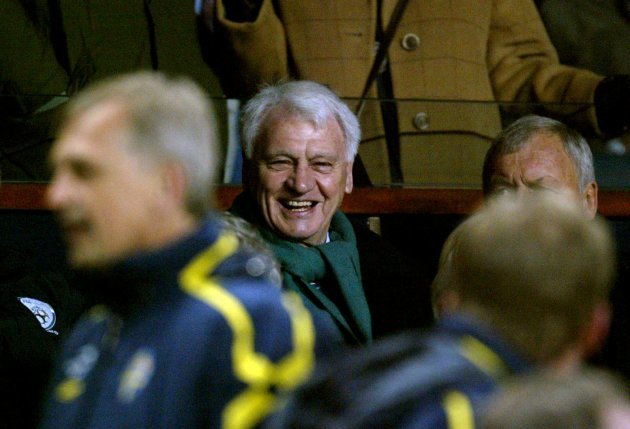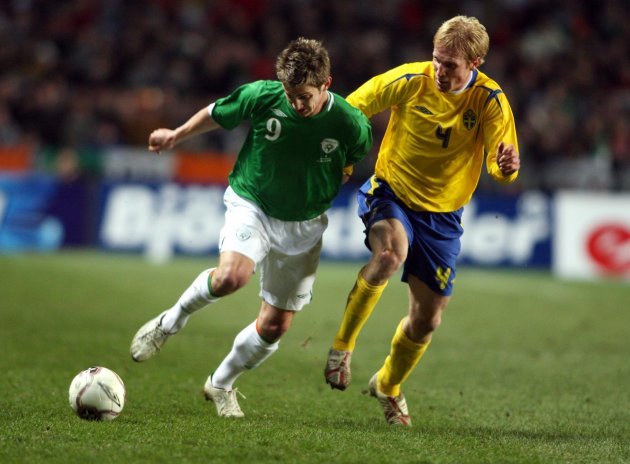Sweden Captain Olof Melberg with Ireland counterpart Robbie Keane. Pic: INPHO/Donall Farmer
JUST UNDER TWO months after his appointment as Ireland manager, Steve Staunton’s first assignment was a friendly against Sweden at Lansdowne Road.
Grabbing the opportunity to experiment with his squad selection, Stan named six previously uncapped players in the 23-man group including the likes of Stephen Ireland and Kevin Doyle.
Unlike their opponents, the Swedes had qualified for the 2006 World Cup and having been drawn to face England in the group stages, felt a physical, combative clash in Dublin would prove the perfect preparation.
But Lars Lagerback’s side were handed a footballing lesson by Staunton’s charges who romped to a 3-0 win. Damien Duff, Robbie Keane and Liam Miller grabbed the goals, the self-styled ‘gaffer’ grabbing the headlines.
The home supporters departing Ballsbridge that night spoke of the endless possibilities. Euro 2008 qualification, perhaps? Staunton kept calm. “We will be trying for the Europeans but realistically we will hopefully be in a lot better shape for 2010,” he told reporters. And they were. Only without Staunton.
But where are those players now?
YouTube: sp1873
Shay Given (Newcastle):
A spectacular servant to his country (125 caps), the Donegal-native retired from international football in August 2012. The European Championship just two months before should’ve been an ideal swansong but instead, his performances came in for criticism. In January of this year, Given announced he was reversing his decision and would be available for selection. Giovanni Trapattoni’s response? Thanks, but no thanks. Ouch.
Now 37, Given’s currently the back-up to Brad Guzan at Aston Villa though Doncaster were keen on a deal earlier this summer.
Ian Harte (Levante):
Harte’s international career faded under Brian Kerr though his club career always intrigued. He was two years into a three-year stint with Levante at the time of the Sweden fixture and played himself back into contention under Staunton with some impressive displays in the Spanish second-tier. But following the club’s promotion, he was surplus to requirements and so began a somewhat nomadic journey through the British scene, including time at Sunderland, Carlisle and Blackpool.
There was a rebirth at Reading, signing for the Royals in August 2010. Their rise saw Harte back in the top-flight last season, making 16 league appearances. He joined Championship side Bournemouth in June. His last Irish appearance came in a European Championship qualifier against San Marino in 2007 though he made headlines earlier this year by describing current Ireland boss Giovanni Trapattoni as a ‘clown’ and claiming the Italian didn’t know he was Irish, something Harte had previously stated in 2011.
Joey O’Brien (Bolton):
Handed his debut against Sweden, O’Brien then endured a nightmare run of injuries that continually interrupted his development. Missing all of the 2006/07 season, he returned to action in September 2007 and featured for Ireland in back-to-back qualifiers against Germany and Cyprus. His frequent appearances in the treatment room led to a lack of action and his eventual release from Bolton in 2011.
Picked up by his former boss Sam Allardyce after a trial at Upton Park, O’Brien was signed by West Ham and has never looked back, playing a key role in the Hammers’ promotion to the top-flight in 2012 and retaining his first-choice credentials in the Premier League. Last year, he was called up to the Irish squad for the first time since 2008 and was been named in the squad for the upcoming qualifiers against Sweden and Austria but has since withdrawn.
Ireland’s Andy O’Brien tackles Christian Wilhelmsson of Sweden. Pic: INPHO/Lorraine O’Sullivan
Andy O’Brien (Portsmouth):
The defender has found a peaceful and tranquil home in Vancouver, where he moved last August, plying his trade with the city’s MLS outfit. A torrid time at Leeds resulted in O’Brien admitting to mental health problems but the move to North America presented him with the perfect opportunity to get back on track.
His last appearance in an Ireland shirt was that infamous 5-2 defeat in Nicosia and despite being called up for a friendly with Brazil in February 2008, O’Brien retired from international football days before the game.
Richard Dunne (Manchester City):
Dunne’s international career really took off under Staunton, with Brian Kerr using the centre-back sparingly during his time in charge. His performances at Manchester City ensured he was made club captain and despite the autumn of discontent at international level (Dunne scored and was later sent-off when Ireland slumped to THAT defeat in Cyprus), his stock was soaring. A move to Aston Villa in 2009 proved successful though Paul Lambert’s arrival as manager, coupled with Dunne’s injury problems led to him being released earlier this summer. Signing for QPR in July, Dunne came through his first 90 minutes since May 2012 earlier this month.
Stephen Elliott and Sweden’s Christian Wilhelmsson. Pic: INPHO/Tom Honan
Stephen Elliott (Sunderland):
An impressive youth international, Elliott was handed his Ireland debut by Brian Kerr in a friendly with Croatia in November 2004. His three years at Sunderland saw him score 22 goals in 55 league starts and during the top-flight campaign of 05/06, he notched in back-to-back games against Manchester United and Newcastle.
But relegation to the Championship saw Elliott fade from both the Black Cats and Irish squads. Between the summers of 2007 and 2012, Elliott had racked up stints at five clubs and was released by Coventry in April of this year.
Steven Reid (Blackburn):
Reid’s form for Blackburn during the 2005/2006 season helped propel the club to UEFA Cup qualification. He was also becoming an important player on the international front too. But, injuries intervened. He effectively missed all of the 06/07 campaign after sustaining a back injury in the 1-0 defeat away to Germany and when he appeared close to a return for Blackburn, he suffered cruciate ligament damage in training.
He made his final appearance for Ireland in a friendly against Norway in August 2008 and retired from the international scene altogether in 2010. He’s been at West Brom since the summer of 2010, making 12 appearances for the club last term.
Bobby Robson looks on from the stands. Pic: INPHO/Donall Farmer
John O’Shea (Manchester United):
In March ’06, O’Shea was just about to finish the season as a United regular. Although always a reliable, consistent performer for his country (an ever-present in 2010 World Cup qualifying), the Waterford-native could never quite convince United of his first-choice capabilities. A move to Sunderland in 2011 saw him command a favoured role at the heart of the Wearsiders’ defence after more than a decade fulfilling utility-man duties at Old Trafford.
Damien Duff (Chelsea):
Duff put in an eye-catching performance against the Swedes and scored his first international goal for two and a half years to give Ireland the lead at Lansdowne. His club form was suffering though. Under Jose Mourinho, Duff had contributed six goals as the club won a Premier League title in 2005, going someway to justifying the £17m fee Chelsea paid for him two years previously. But he struggled for consistency and his three-goal tally in 2006 led to an inevitable move elsewhere. A three-year spell at Newcastle was overshadowed by injuries, loss of form and the club’s relegation.
At Craven Cottage since August 2009, Duff has established himself as a critical component in the side. Always an important player for his country, Duff reached a century of appearances during Euro 2012 and was handed the captain’s armband to mark the occasion against Italy. He announced his international retirement in August 2012.
Robbie Keane (Tottenham):
Perhaps best known as a relation of Morrissey’s, Keane is also Ireland’s record caps holder and goal-scorer. The Sweden game proved a big moment for the attacker as he was handed the captain’s armband, taking over from the recently-retired Kenny Cunningham. He’d finish the season with 16 Premier League goals to his name – his best ever tally. Though his goal-scoring at international level exploded during qualification for the 2010 World Cup and 2012 European Championship, he was enduring a dry period for Ireland across 2005 and 2006. Leaving Spurs in 2008, Keane had spells with Liverpool, Spurs (again) Celtic and West Ham before moving to MLS and Los Angeles Galaxy in 2011. In his first season with the franchise, they won the MLS Cup trophy and repeated the trick last year.
Ireland’s Kevin Doyle is tackled by Sweden’s Petter Hansson. Pic: INPHO/Tom Honan
Kevin Doyle (Reading):
This was Doyle’s full international debut and it came as a result of his Championship performances. Having been signed from Cork City the previous summer, he had already scored 15 goals. He racked up his first international goal in a European Championship qualifier against San Marino and promised much. Across 2007, there were more goals — home and away against Slovakia, against Wales too. But with Giovanni Trapattoni’s arrival as Ireland manager, Doyle was asked to play a different role and despite more goals for Reading, his international strike-rate dropped. A move to Wolves in 2009 hinted at a return to form but he’s failed to hit double-figures in any of his four full seasons at Molineux. The club’s relegation from the top-flight in 2012 saw Doyle back at Championship level and despite nine league goals, he couldn’t keep the side afloat.
A demoralising drop to League One occurred in May and Doyle’s most recent outing was a clash with Port Vale.
Wayne Henderson (Brighton):
Another product of one of Irish football’s most famous families, Henderson replaced Given early in the second half to make his senior debut. He would go on to make five further appearances before failing to impress Staunton’s successor, Trapattoni. Retired from the game in 2011, aged just 27, after a series of injuries.
Liam Miller (Leeds, loan):
Miller’s first season at Manchester United saw him make 20 appearances but his impact at Old Trafford was muted in comparison to the splash he made at Celtic. In late 2005, Miller was sent on loan to Leeds and featured prominently as the club made it to the Championship play-offs. His performances failed to impress Alex Ferguson sufficiently and a few months after scoring Ireland’s third goal against the Swedes, he was moved to Sunderland. Spells at QPR and Hibs followed before Miller made the move to Australia in 2011, joining Perth Glory. In May 2013, he moved to Brisbane Roar.
Kevin Kilbane (Everton):
Kilbane was coming to the end of a three-year stint at Goodison Park in March 2006. The previous season, he was integral to the Merseysiders fourth-place finish and subsequent Champions League qualification. Despite the domestic switch, he still had plenty to offer at international level, playing his last game for Ireland in a Euro 2012 qualifier against Macedonia.
Grahan Kavanagh (Wigan):
Kavanagh’s career reached its zenith during the 2005/2006 season as Wigan experienced their first ever Premier League season – the midfielder helping steer the club to an incredible top-10 finish. He played out the rest of his career at Sunderland, Sheffield Wednesday and Carlisle, where he’s currently assistant manager. He racked up 16 Ireland caps.
Stephen Ireland (Manchester City):
Ireland was called up to the senior side for the first time for the game against Sweden and came on for the majority of the second half. In October, he scored his first international goal in the humiliating defeat to Cyprus. His international career would start and end under Steve Staunton, a litany of controversial incidents overshadowing his unquestionable on-field talent. In October 2008, Ireland said he wouldn’t be making himself available for international selection for the forseeable future and despite repeated efforts from Giovanni Trapattoni to attempt to re-integrate the midfielder into the Irish set-up, Ireland stayed away. Despite being named Manchester City’s Player of the Year for 08/09, Ireland left the club in 2010, moving to Aston Villa for £10m. But he’s endured a miserable time in the midlands, failing to command a regular starting place. A loan spell with Newcastle did more harm to his career than good and at 27, Ireland’s next move is critical.
Liam Miller and Clinton Morrison celebrate after Miller’s goal. Pic: INPHO/Lorraine O’Sullivan
Clinton Morrisson (Crystal Palace):
Morrison scored three times during the qualification for 2006 World Cup and was a favourite of Brian Kerr’s. But despite continuing to score goals for Palace in the Championship, Steve Staunton preferred to pair Robbie Keane with Kevin Doyle. Morrison would make two further appearances for the international side and after spells with Coventry, Sheffield Wednesday, MK Dons and Brentford, he’s currently with Colchester in League One, scoring twice for them last term.






